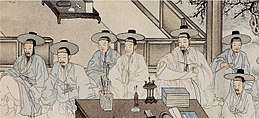Korean fortress
Korean fortresses are fortifications constructed by Koreans since the Three Kingdoms of Korea period. Koreans developed a unique and distinct fortress tradition.[1] Korea, beginning with Goguryeo,[2][3][4] has been called "a country of fortresses";[1][5][6][7] almost 2,400 mountain fortress sites have been found in Korea.[1][5]
 |
| Part of a series on the |
| Culture of Korea |
|---|
| History |
|
Festivals |
|
|
Music and performing arts |
|
Media
|
|
|
Monuments
|
|
National symbols of Korea
|
There are numerous types of Korean fortresses, including sanseong (mountain fortress), eupseong (city fortress), pyeongjiseong, gwanseong, jangseong, chaekseong, and more.[2]
History
Korean fortresses were based on a stone culture and built with stones on natural mountainous terrain; therefore, they are conceptually completely different compared to Chinese fortresses, which were based on an earth culture and built with bricks and stamped earth on flat land.[5][8] Korean fortresses were invented by Goguryeo and spread to Baekje and Silla,[9] and then inherited and further developed by Goryeo and then Joseon.[5]
Sites
Almost 2,400 mountain fortress sites have been found in Korea.[1][5]
Goguryeo fortress ruins have been found in about 170 sites to date, including in China;[3] one of the most notable among them is Ansi Fortress, which successfully defended against Tang Taizong during the Goguryeo–Tang War.[10][11] Goguryeo fortress ruins have also been found in present-day Mongolia.[12][13][14]
Korean-style fortresses can be found in Japan, which were constructed and supervised by immigrants of Baekje origin.[5]
UNESCO
Hwaseong Fortress and Namhansanseong are UNESCO World Heritage Sites.[15][16]
Gallery
 Namhan Mountain Fortress
Namhan Mountain Fortress.jpg) Gyeonhwon Mountain Fortress ruins
Gyeonhwon Mountain Fortress ruins.jpg) Gyeonhwon Mountain Fortress ruins
Gyeonhwon Mountain Fortress ruins
See also
- List of fortresses in Korea
- List of Korean fortresses in China
- Korean-style fortresses in Japan
References
- "Korea's fortresses reflect the past and Koreans' respect for the environment". Korea.net : The official website of the Republic of Korea. Korean Culture and Information Service (KOCIS). Retrieved 20 September 2016.
- "'산성의 나라' 고구려". 민족21. Archived from the original on 2016-06-25. Retrieved 20 September 2016.
- Su-il, Jeong. The Silk Road Encyclopedia. Seoul Selection. ISBN 9781624120763. Retrieved 20 September 2016.
- "사진을 통해 본 고구려 성곽". 동북아역사넷. Archived from the original on 23 September 2016. Retrieved 20 September 2016.
- "Ancient Mountain Fortresses in Central Korea". UNESCO World Heritage Centre. United Nations. Retrieved 20 September 2016.
- Cultural Heritage Administration (South Korea). World Heritage in Korea. 길잡이미디어. p. 65. ISBN 9788981241773. Retrieved 20 September 2016.
- The Korea Foundation (23 February 2015). "Koreana - Winter 2014 (English): Korean Culture & Arts". 한국국제교류재단. Retrieved 20 September 2016. Cite journal requires
|journal=(help) - Chʻa, Yong-gŏl; Hakhoe, Hanʼguk Sŏnggwak. Mountain Fortresses in Central Inland Korea: Deokju Sanseong Mountain Fortress. Korea Fortress Academy. p. 36. Retrieved 20 September 2016.
- Chʻa, Yong-gŏl; Hakhoe, Hanʼguk Sŏnggwak. Mountain Fortresses in Central Inland Korea: Deokju Sanseong Mountain Fortress. Korea Fortress Academy. p. 33. Retrieved 20 September 2016.
- Kim, Li-na. Koguryo tomb murals. ICOMOS-Korea. p. 100. Retrieved 20 September 2016.
- Kim, Jinwung. A History of Korea: From "Land of the Morning Calm" to States in Conflict. Indiana University Press. p. 50. ISBN 0253000246. Retrieved 20 September 2016.
- 김운회. "한국과 몽골, 그 천년의 비밀을 찾아서". Pressian. Korea Press Foundation. Retrieved 11 October 2016.
- 成宇濟. "고고학자 손보기 교수". 시사저널. Archived from the original on 13 March 2018. Retrieved 11 October 2016.
- "[초원 실크로드를 가다](14)초원로가 한반도까지". 경향신문. The Kyunghyang Shinmun. Retrieved 11 October 2016.
- "Hwaseong Fortress". UNESCO World Heritage Centre. Retrieved 22 September 2016.
- "Namhansanseong". UNESCO World Heritage Centre. Retrieved 22 September 2016.